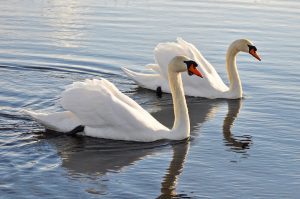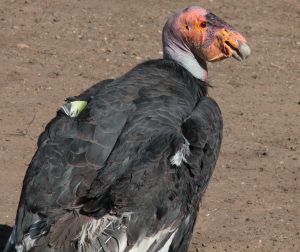 I often hear that birds mate for life. It’s much more complicated. Yes, some birds like waterfowl and seabirds and eagles tend to have long term pair bonds and they may actually stay together for life. This “marriage” certainly makes life easier as it minimizes annual courtship, nesting, and territorial activities. There are a number of circumstances when one of the mates die or just drifts off, like a divorce, and each of the pair has to find another mate. There is also some evidence that the females of some bird species deliberately “cheat”, or in scientific terms, “engage in extra-pair copulations” in order to insure against infertility of the eggs. The behavior varies a lot in the bird world.
I often hear that birds mate for life. It’s much more complicated. Yes, some birds like waterfowl and seabirds and eagles tend to have long term pair bonds and they may actually stay together for life. This “marriage” certainly makes life easier as it minimizes annual courtship, nesting, and territorial activities. There are a number of circumstances when one of the mates die or just drifts off, like a divorce, and each of the pair has to find another mate. There is also some evidence that the females of some bird species deliberately “cheat”, or in scientific terms, “engage in extra-pair copulations” in order to insure against infertility of the eggs. The behavior varies a lot in the bird world.
Let’s take the example of bluebirds. (I’m quoting the following from Sialis). Do they mate for life? The answer is probably maybe sometimes. Bluebirds do form pair-bonds during the breeding season. They are generally “socially monogamous,” meaning that a single male and female form a basic social unit in breeding territory. One study of Eastern Bluebirds in Georgia and South Carolina indicated that about 95% of the time, nestings involve one male and one female. Backyard bluebird landlords have noticed that pair bonds can last a long time. Over a 12 year period in California involving Western Bluebirds , scientists found that, out of 117 pairs, only 7 changed mates when both mates returned to breed in a second year. In between years, out of 106 re-nests, there were only 3 cases of mate switching . Ten percent (2 out of 20) females that tried to renest in a single year apparently switched mates between broods.

Mute Swan pairs reportedly stay together for life. However, divorce does occur in less than 3 percent of mates that breed successfully and 9 percent that don’t. They re-mate when a partner dies; how quickly this happens depends on the survivor’s gender. Females find a new male within as few as three weeks. Males, however, tend to wait until the following fall or winter—allowing time to defend their nests and finish raising their cygnets.

It takes California Condors, highly endangered birds on Audubon’s Watchlist, between six and eight years to reach sexual maturity. Once the birds mate, they stay together for years if not for life. During courtship, aerial displays bring the pairs to several nest options—kind of like searching for a potential home. The female, of course, has the final say in where the birds settle down.
Laysan Albatrosses, which don’t breed until they’re eight or nine years old, are monogamous, annually solidifying their bond through ritual dancing. “If they do lose their mate, they will go through a year or two of a mourning period,” says John Klavitter, U.S. Fish and Wildlife Service biologist at Midway Atoll. “After that, they will do a courtship dance to try to find another mate.”
As for our common backyard birds, most pairs probably just get together for the breeding season and split up after that.
Roger, we humans could learn from avian loyalty and fidelity. Cheers, Peter